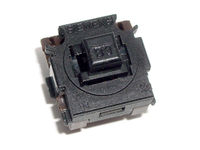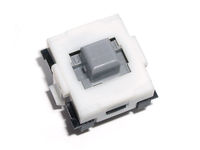Difference between revisions of "Siemens STB"
Jump to navigation
Jump to search
(Moved description and history sections back from the STB nn pages and expanded them. Distributed the remaining keyboards to the STB nn pages.) |
m (→History: Corrected link to ST family) |
||
| (10 intermediate revisions by 3 users not shown) | |||
| Line 1: | Line 1: | ||
The '''Siemens STB''' "Schreibtasten" are a switch family from [[Siemens AG|Siemens]] with two compatible series: | The '''Siemens STB''' "Schreibtasten" are a switch family from [[Siemens AG|Siemens]] with two compatible series: | ||
| − | {| class="wikitable" | + | {| class="wikitable variants-table" |
|- | |- | ||
| − | | [[File:Siemens STB 11 V42263-D11K6 -- top.jpg|200px]] || '''[[Siemens STB 11|STB 11]]''' <br />Initial series with greater variety of models and applications | + | |[[File:Siemens STB 11 V42263-D11K6 -- top.jpg|200px]]||'''[[Siemens STB 11|STB 11]]''' <br />Initial series with greater variety of models and applications |
|- | |- | ||
| − | | | + | |[[File:Siemens STB 21 V23758-A2133-A5 -- top.jpg|200px]]||'''[[Siemens STB 21|STB 21]]''' <br /> Replaced [[Siemens STB 11|STB 11]] in standard applications |
|} | |} | ||
| Line 11: | Line 11: | ||
==Description== | ==Description== | ||
| − | * Square-post keycap mount with the same fastening mechanism as with [[RAFI Full-Travel Keyswitch|RAFI RS]] switches, partly compatible. | + | |
| − | * Characteristic spherical top-hat keycaps, but also mesa- | + | *The series designations STB 11 and STB 21 stand for ''Schreibtaste'' (where ''B'' is possibly meant to differentiate it from the Siemens Albis or the [[Siemens ST|ST]] families), series ''1'' or ''2'', ''single'' pole |
| − | * Key feel: all switches of the family have a silent tactile bump at about half the travel length. Except for the foil-sealed variants, the depression force rises linearly from 50 to 100 cN with a tactile bump at 65 - 75 cN. | + | *Both series have variants with 4 mm travel (which Siemens used for keyboards) and with 2.5 mm travel (which Siemens used for panels). |
| − | + | *Square-post keycap mount with the same fastening mechanism as with [[RAFI Full-Travel Keyswitch|RAFI RS]] switches, partly compatible. | |
| − | + | *Characteristic spherical top-hat keycaps, but also mesa-shaped keycaps exist. | |
| + | *Key feel: all switches of the family have a silent tactile bump at about half the travel length. Except for the foil-sealed variants, the depression force rises linearly from 50 to 100 cN with a tactile bump at 65 - 75 cN. This can be likened to [[Cherry MX Black]] with an added tactility similar to [[Cherry MX Brown|MX Brown]] (light variant) or a bit more than [[Cherry MX Clear|MX Clear]] (heavy variant). | ||
==History== | ==History== | ||
| − | * These switches were developed to be used for keyboards by Siemens and its subsidaries (esp. Tandberg). They were produced by the Siemens Electromechanical Components (EC) division, who made the complete set of switches and accessories generally available, so that also smaller German and Scandinavien manufacturers could use them for their small-series keyboards. | + | |
| − | * Development began in 1977, after German ergonomics experts had suggested that desktop computer keyboards should have home rows no higher than 30 mm. They started from the [[Siemens 8160 terminal]] keyboard as their gold standard and aimed at preserving its strengths while moving to something similar to the [[RAFI S77]] keyboard. Intermediately, they started using [[RAFI Full-Travel Keyswitch|RAFI RS]] family switches for their products. | + | *These switches were developed to be used for keyboards by Siemens and its subsidaries (esp. Tandberg). They were produced by the Siemens Electromechanical Components (EC) division, who made the complete set of switches and accessories generally available, so that also smaller German and Scandinavien manufacturers could use them for their small-series keyboards. |
| − | * Design goal was a low-profile switch with 4 mm travel like the [[RAFI RS 76 M]] with a feel similar to the [[Siemens | + | *Development began in 1977, after German ergonomics experts had suggested that desktop computer keyboards should have home rows no higher than 30 mm. They started from the [[Siemens 8160 terminal]] keyboard as their gold standard and aimed at preserving its strengths while moving to something similar to the [[RAFI S77]] keyboard. Intermediately, they started using [[RAFI Full-Travel Keyswitch|RAFI RS]] family switches for their products. |
| − | * First prototype terminals with [[Siemens STB 11|STB 11]] switches were available for testing at the Siemens Ergonomics Institute in 1979. | + | *Design goal was a low-profile switch with 4 mm travel like the [[RAFI RS 76 M]] with a feel similar to the [[Siemens ST]] switch. |
| − | * The STB 21 series was designed as a simpler (and cheaper) alternative for standard applications. It superseded the STB 11 series as the preferred part in 1985. | + | *First prototype terminals with [[Siemens STB 11|STB 11]] switches were available for testing at the Siemens Ergonomics Institute in 1979. |
| − | * As far as we know, the last Siemens systems that had alphanumeric keyboards with STB keys were the Simatic programming units of the [[Siemens PG 710/730|PG 710/730]] and [[Siemens PG 750/770|PG 750/770]] series by the Siemens Automation division, the last of which were built in 1995. Siemens Data division already had given up on mechanical keyboards in 1989, shortly before they were merged with [[Nixdorf]] in 1990 | + | *The STB 21 series was designed as a simpler (and cheaper) alternative for standard applications. It superseded the STB 11 series as the preferred part in 1985. |
| − | * As opposed to the STB 11 series, the STB 21 series seems to have already disappeared before Tyco bought Siemens EC business in 1999. Tyco took the STB 11 switches off the catalogue in the course of a general consolidation in 2001. | + | *As far as we know, the last Siemens systems that had alphanumeric keyboards with STB keys were the Simatic programming units of the [[Siemens PG 710/730|PG 710/730]] and [[Siemens PG 750/770|PG 750/770]] series by the Siemens Automation division, the last of which were built in 1995. Siemens Data division already had given up on mechanical keyboards in 1989, shortly before they were merged with [[Nixdorf]] in 1990. They produced rubber dome boards with caps that looked like STBs, until a new rubber dome keycap shape was introduced in 1993 that dominated the Siemens-Nixdorf and [[Fujitsu Siemens Computers|Fujitsu-Siemens]] eras (cf. the [[Fujitsu Siemens KBPC S2|KBPC S2]] keyboard). |
| + | *As opposed to the STB 11 series, the STB 21 series seems to have already disappeared before Tyco bought Siemens EC business in 1999. Tyco took the STB 11 switches off the catalogue in the course of a general consolidation in 2001. | ||
[[Category:Siemens switches]] | [[Category:Siemens switches]] | ||
Latest revision as of 15:11, 5 September 2019
The Siemens STB "Schreibtasten" are a switch family from Siemens with two compatible series:
 |
STB 11 Initial series with greater variety of models and applications |
 |
STB 21 Replaced STB 11 in standard applications |
The STB 21 switches are drop-in replacements for the STB 11 series.
Description
- The series designations STB 11 and STB 21 stand for Schreibtaste (where B is possibly meant to differentiate it from the Siemens Albis or the ST families), series 1 or 2, single pole
- Both series have variants with 4 mm travel (which Siemens used for keyboards) and with 2.5 mm travel (which Siemens used for panels).
- Square-post keycap mount with the same fastening mechanism as with RAFI RS switches, partly compatible.
- Characteristic spherical top-hat keycaps, but also mesa-shaped keycaps exist.
- Key feel: all switches of the family have a silent tactile bump at about half the travel length. Except for the foil-sealed variants, the depression force rises linearly from 50 to 100 cN with a tactile bump at 65 - 75 cN. This can be likened to Cherry MX Black with an added tactility similar to MX Brown (light variant) or a bit more than MX Clear (heavy variant).
History
- These switches were developed to be used for keyboards by Siemens and its subsidaries (esp. Tandberg). They were produced by the Siemens Electromechanical Components (EC) division, who made the complete set of switches and accessories generally available, so that also smaller German and Scandinavien manufacturers could use them for their small-series keyboards.
- Development began in 1977, after German ergonomics experts had suggested that desktop computer keyboards should have home rows no higher than 30 mm. They started from the Siemens 8160 terminal keyboard as their gold standard and aimed at preserving its strengths while moving to something similar to the RAFI S77 keyboard. Intermediately, they started using RAFI RS family switches for their products.
- Design goal was a low-profile switch with 4 mm travel like the RAFI RS 76 M with a feel similar to the Siemens ST switch.
- First prototype terminals with STB 11 switches were available for testing at the Siemens Ergonomics Institute in 1979.
- The STB 21 series was designed as a simpler (and cheaper) alternative for standard applications. It superseded the STB 11 series as the preferred part in 1985.
- As far as we know, the last Siemens systems that had alphanumeric keyboards with STB keys were the Simatic programming units of the PG 710/730 and PG 750/770 series by the Siemens Automation division, the last of which were built in 1995. Siemens Data division already had given up on mechanical keyboards in 1989, shortly before they were merged with Nixdorf in 1990. They produced rubber dome boards with caps that looked like STBs, until a new rubber dome keycap shape was introduced in 1993 that dominated the Siemens-Nixdorf and Fujitsu-Siemens eras (cf. the KBPC S2 keyboard).
- As opposed to the STB 11 series, the STB 21 series seems to have already disappeared before Tyco bought Siemens EC business in 1999. Tyco took the STB 11 switches off the catalogue in the course of a general consolidation in 2001.